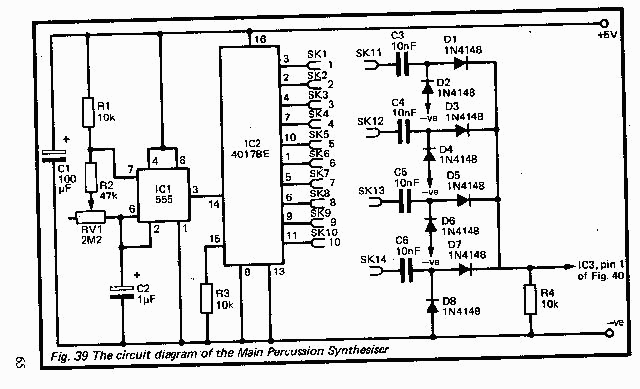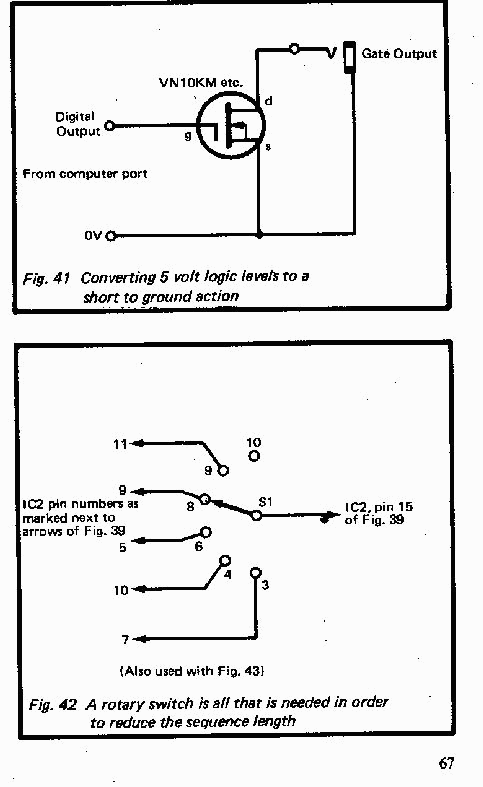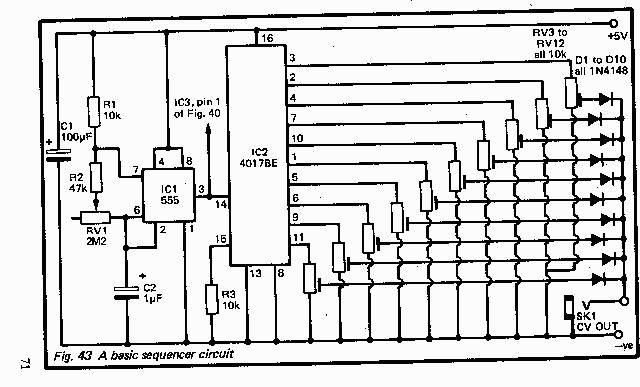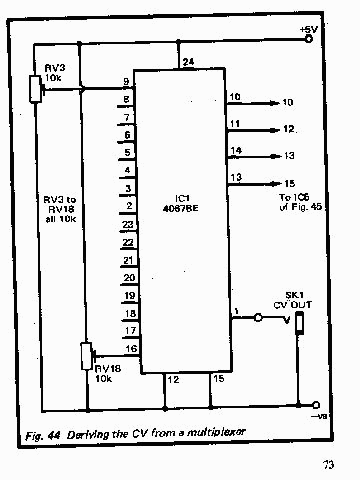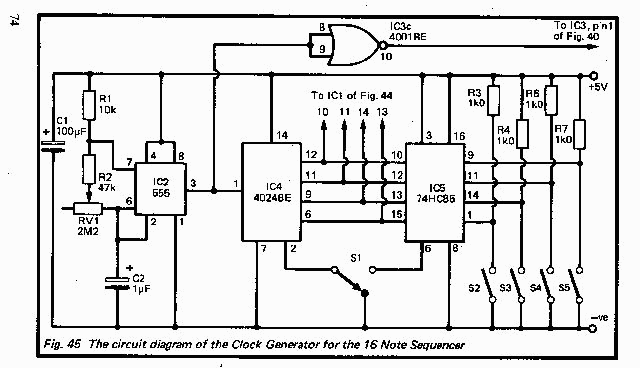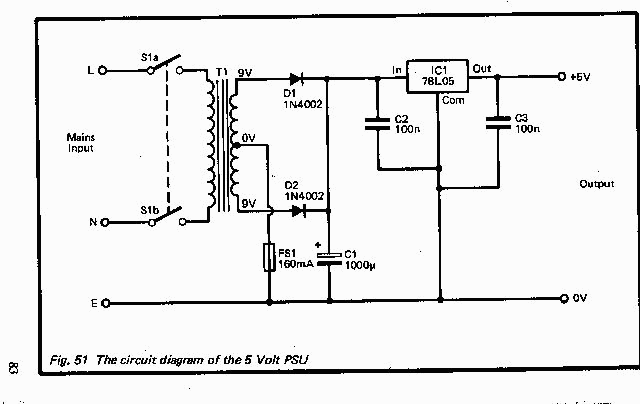Chapter 3
SEQUENCING
Automatic sequencing of a synthesiser is a common practise, and one which has two main applications. Probably the more popular of these is to have a short sequence of notes which is repeated indefinitely, and this acts as a backing while a “live” melody line is played. The other application is where long sequences of notes are programmed and systems of this type often have numerous channels. This type of sequencing enables composers and arrangers to experiment with ideas, and to try out piece of music which are beyond their playing ability. In fact sequencers can play any music note - perfectly, no matter how demanding it may be, and some of the experimental music currently being written can only be performed by electronic means.
Whether short repetitive sequences are required, or long and difficult pieces are to be played automatically, there are two basic types of sequencer which can be used. These are the “real-time” and “step-time” varieties. With a real-time sequencer the notes are entered into the system by playing them on the keyboard, and the sequencer records the notes that are played, the times between notes, and with some systems even how hard the notes; are played. This information is extracted via the gate and CV sockets, or via the MIDI interface, as appropriate. The sequencer can then play back exactly what was played during the recording process, but refinements often allow such things as note duration correction (making notes precisely the correct duration even if the playing was a bit untidy), and the ability to speed up or slow down the tempo. Real-time sequencing is preferred by many musicians as it provides a fast means of entering the required sequence of notes, but it obviously demands a fair degree of playing competence on the part of the user, even if multipart music is entered one or two lines at a time. Step-time sequencing involves no playing whatever, and the exact method of entering the notes depends on the particular system in use. With a simple system it might involve setting a few switches or connecting patch-cords, with a computer based system and a light-pen being used in top of the range equipment. Entering music into a step-time sequencer is a relatively -slow business, but it is an attractive method for many users as it requires no playing skill at all, and gives note-perfect results every time. At least, it gives perfect results provided no programming errors are made, but even if a mistake should be made it is usually quite easy to edit it out.
It is quite feasible to build complex step-time or real-time sequencers, but it is generally easier to base such systems oil a home computer rather than build them from scratch. This is a subject which we will not consider here as it really goes well beyond the scope of this book. However, it is a topic which is covered in the books No. BP173: “Computer Music projects” and No. BP182: “MIDI Projects”, both of which are from the same publisher and author of this publication.
Percussion Sequencer
Simple step-time sequencers are something that can be easily built by the home constructor, and although their usefulness is low in comparison to complex sequencers, taking into account the very low costs involved they are still a worthwhile proposition. If a percussion synthesiser (or an ordinary synthesiser used as a percussion synthesiser) is to be sequenced, then it will often only be necessary to generate a series of gate pulses having the required rhythm, and no control voltage output will be required. Figure 39 shows the main circuit for a, simple percussion sequencer.
The clock signal is generated by IC1 which is a 555 timer device connected in the standard astable (oscillator) mode. RV1 enables the operating frequency to be adjusted from about ten pulses per second to around one pulse every four seconds. RV1 is effectively the tempo control.
IC2 is a 4017BE decade counter and one of ten decoder. In this application it is only the one of ten decoder action that is required. In this role the device has ten outputs, one of which goes high while all the others take up the low state. Initially it is output '0' that is high, but on subsequent clock pulses output '1' goes high, then output '2', and so on. After output '9' has gone high the circuit cycles back to output 'O' going high on the next clock pulse, and this sequence repeats indefinitely.
The 4017BE is popular for simple sequencing applications as it is not difficult to use the outputs to provide simple rhythm patterns. In this case each output is taken to a 2 millimetre socket, and the required outputs are patched through to a sort of mixer circuit based on D 1 to D8. For instance, if we assume that outputs 1, 4, 5, and 7 are to be used, these would be connected through to SKI1, SK12, SKI3, and SKI4 (one output connecting to each input of the mixer). The purpose of the mixer is to generate short positive pulses on the leading edge of each output pulse from 1C2. Although at first sight it might seem that a conventional OR gate action is all that is required, things are not quite as simple as this. If (say) output'l'and'2'were to be logic 0Red, as output '1' went low output '2' would go high, giving no change in the output from the gate. In other words, rather than two distinct output pulses, one double length pulse would be obtained. By giving a brief pulse on the leading edge of each output pulse the mixer circuit does provide two distinct output pulses. By adding extra stages to the mixer circuit it could provide more than four output pulses per IC2 cycle, but in practice four stages should be sufficient.
The output pulses from this circuit are incompatible with the gate and trigger inputs of most synthesisers, but the simple circuit of Figure 40 is all that is needed in order to give an output at standard 5 volt logic levels. Most synthesisers which require nominal + 15 volt trigger pulses are also designed to respond to + 5 volt signals, and should work perfectly well with this circuit. For synthesisers that require a short-to-ground gate signal a VMOS transistor should be added at the output of the circuit, as shown in Figure 41. The circuit of Figure 40 is a basic CMOS monostable circuit, and RV2 enables the gate output pulse duration to be varied from around 5 milliseconds to approximately 500 milliseconds. However, bear in mind that when using a fast tempo the gate pulse must be quite short, or a trigger pulse might be received before the previous output pulse has ceased, resulting in missing beats. A major drawback of the unit is that it can only produce rhythms based on ten units of time. It can be made much more versatile by adding a six way switch, as shown in Figure 42. This switch enables a selected output to be connected to the reset input of IC2. Thus, when the selected output goes high, 1C2 is immediately reset to '0', and each cycle is cut short. This enables the unit to produce rhythms based on 3, 4, 6, 8, 9, or 10 units of time.
Percussion Sequencer Components (Figs. 39 & 40)
Resistors (all 1/4 watt 5%) Rl,3,4 10k R2 47k R5 22k Potentiometers RV1,2 2M2 linear Capacitors C1 100uF lOV radial electrolytic C2 1uF 63V radial electrolytic C3,4,5,6 10nF miniature polyester C7 47OnF miniature polyester Semiconductors IC1 555 1C2 4017BE 1C3 4001BE Miscellaneous SK1 to SK14 2mm sockets SK15 Standard Jack socket S1 6 way 2 pole rotary switch Printed circuit board Four leads fitted with 2mm plugs Two control knobs, IC holders, wire, etc.
10 Note Sequencer Components (Figs. 40, 42 & 43)
Resistors (all 1/4 watt 5%) Rl,3 10k R2 47k R5 22k Potentiometers RV1,2 2M2 linear RV3 to RV12 10k miniature horizontal preset Capacitors C1 100uF 10V radial electrolytic C2 l uF 63V radial electrolytic C7 47OnF miniature polyester Semiconductors ici 555 1C2 4017BE 1C3 4001BE .D1 to D10 1N4148 Miscellaneous S1 6 way 2 pole rotary SK1,15 Standard jack socket Printed circuit board Two control knobs, IC holders, wire, solder, etc. 16 Note Sequencer Components (Figs. 40, 44 & 45)
Resistors (all 1/4 watt 5%) Rl 10k R2 47k R3,4,6,7 lk R5 22k Potentiometers RV1,2 2M2 linear RV3 to RV18 10k miniature horizontal preset Capacitors C1 100uf 10V radial electrolytic C2 1uF 63V radial electrolytic C7 47OnF miniature polyester Semiconductors ici 4067BE 1C2 555 IC3 4001BE IC4 4024BE IC5 74HC85 Miscellaneous S1 SPST miniature toggle type SK2,3,4,5 Four SPST miniature toggle switches or one hex switch SK1,15 Standard jack socket Circuit board, IC holders, wire, solder, etc.
Note Sequencing
Sequencing notes rather than just rhythms is, on the face of it, a much more difficult prospect, as a range of voltages must be provided. In fact sequencing notes is not particularly difficult @ and requires little more than the addition of a few potentiometers.' Figure 43 shows the circuit diagram of a simple note sequencer circuit.
This has obvious similarities with the Percussion Sequencer which was described previously, and the main difference is the addition of a preset potentiometer at each output of the 4017BE. A simple gate is formed by the ten diodes, and its purpose is to enable the voltage from whichever output is activated to reach the output socket unhindered. Without the diodes the preset resistors in the other channels would load the active output, reducing the maximum available voltage. It would also make the unit practically impossible to tune since adjusting one preset would affect the tuning of all the, others.
The circuit can provide output voltages of up to about 4.3 volts, The maximum output voltage is slightly less than the supply voltage due to the voltage drop through the output diodes, and because IC2 provides a “high” output voltage which is slightly less than the full supply voltage. This enables a range of just over four octaves to be covered with a standard 1 volt per octave s synthesiser, and this should be adequate for most purposes. A larger range could be provided by increasing the supply voltage, which can be up to 15 volts. However, this would also increase the gate output potential, and this is unacceptable with synthesisers that are designed to accept a 5 volt signal. It is, of course, quite acceptable with synthesisers that are designed for use with a + 15 volt gate pulse, and it is also satisfactory if a VMOS transistor is used to provide a suitable gate signal for a “short to ground” gate input.
The inclusion of a diode in series with the output of each timing potentiometer does result in slight variations in the tuning voltage with changes in the ambient temperature, but in practice this factor does not seem to introduce significant tuning drift. Any Variations in the power supply voltage will introduce tuning drift though, and for this reason it is important to power the unit from a well smoothed and regulated power supply.
Of course, a gate pulse generator is required, and the most simple way is to derive the pulse from pin 1 of IC3 as shown in the circuit of Figure 40. Alternatively, the diode mixer circuit from the percussion synthesiser can be used to drive the gate impulse generator circuit. The first method has the advantage of simplicity, but it is restrictive in that each note has to be of the same duration, and there is no control over the rhythm apart from the tempo. The second method permits simple rhythm patterns to be generated, but at the cost of reduced note capacity and increased complexity. Whichever method is adopted, it is advisable to include S1 (Figure 42) so that the number of notes in the sequence can be reduced if required.
16 Note Sequencer
It is possible to produce longer sequences than 10 notes, but for really long sequences a complex circuit based on analogue-digital-analogue conversion techniques is required. However, if only a few extra notes are required it is possible to achieve this using relatively simple circuits. The circuit diagram of Figure 44 shows how a CMOS analogue switch can be used as the basis of a sequencer. IC1 is a CMOS 4067BE sixteen way single pole type. The sixteen inputs are fed from individual tuning potentiometers (but for clarity only two of these are shown in Figure 44). each one of the tuning voltages is fed through the device and out to the output socket depends on the four bit binary code fed to the address inputs of the device. Figure 45 shows the circuit diagram for the clock generator and counter which generates the sequence of four bit addresses. This has a 555 clock oscillator (as in the previous sequencer circuits) driving a seven stage binary counter (IC4). Only the first four stages of IC4 are utilized, and these provide the four bit addresses for 1C1. This results in RV3 to RV18 being switched through to the output ' in sequence, and the circuit cycles in this way indefinitely.
Obviously it is advantageous if there is some means of reducing -the sequence length available, and this is made possible by the inclusion of IC5. This is a 74HC85 four bit comparator, and it compares the output code of IC4 with the binary code provided by S2 to S5 and the four load resistors. When the two codes are the same the output of 1C5 goes high, and provided S1 is set to connect IC5 through to the reset input of IC4, 1C4 is reset to zero and the count is shortened. S1 connects the reset input of IC4 to the negative supply rail when IC5 is switched out of circuit.
S2 to S5 can be miniature toggle switches, or a type of switch known as a “hex” (hexadecimal) switch can be used. The latter is a sixteen way rotary switch which is calibrated “O” to “15” and. provides the appropriate binary output code for each number. This option is by far the more convenient in use since it avoids having to convert decimal numbers to their four bit binary alternative before the switches can be set correctly. If you choose to use a hex switch, be careful to obtain the correct type. The switch must be of the type where an output which is to be at binary 0 is connected to the common terminal, and not a type where the switch is open when the output it drives is at binary 0. Of course 'I in the current context switch positions “O” and ' 1 “ are of no practical value, since sequences 0 or 1 note long are obviously nonsensical, and switch position “2” is the lowest that should ever be selected. Accidentally setting the hexadecimal switch to '0” or “1” will not damage the circuit though (it will simply result in the first note being held continuously), and there is no need to implement some means of eliminating these positions. Incidentally, hexadecimal switches are usually printed circuit rather than panel mounting types, and this is something which must be taken into account when designing the component layout, etc. Alternatively, with a little ingenuity it should be possible to devise a method of panel mounting one of these components.
A limitation of this circuit is that it only permits each note to be of the same duration, and there is no easy way around this problem. The gate circuit used in the Percussion Synthesiser is not applicable in this case as there are no separate outputs from the 4067BE at logic levels to drive this circuit. The gate pulse generator circuit of Figure 40 is used to provide the gate output signal, but note that this circuit is driven via one of the previously unused gates of 1C3 (IC3c) in order to synchronise the gate pulses with changes in the tuning voltage.
Construction
Printed circuit designs for the Percussion Sequencer and the 10 Note Sequencer are provided in Figures 46 to 49. No printed circuit design is given for the 16 note type, but there should not be too much difficulty in building this on 0.1 inch stripboard, The 74HC85 device specified for the 16 Note sequencer might be a little difficult to obtain, and this is the high speed CMOS version of the 7485 TTL device. The standard CMOS 4063BE type is a pin for pin equivalent to the 74HC85, and in this circuit where ultrafast operation is not required it is a suitable alternative, Note that the 74HC85, 4063BE, 4001BE, 4017BE, 4024BE, and 4067BE are all CMOS devices, and that they consequently require the standard MOS antistatic handling precautions.
Construction of these projects should not be difficult, but with the percussion synthesiser try to use a well laid out front panel so that there is no difficulty in wiring the sockets together in the required manner. It is also advisable to clearly label the sockets so that it is easy to wire things up in the required way, with mistakes being avoided. In fact with any music project it is advisable to clearly label all controls and sockets, especially with projects that have numerous controls and (or) sockets. Rub-on letter transfers are available from some of the larger electronic component retailers, and they are also available from many stationers and graphic art supply shops. With the aid of these it is possible to produce some really professional looking front panels, but it is advisable to protect the finished panels with a spray-on lacquer, as rub-on transfers rub-off almost as easily from many plastic and metal surfaces. If you do not wish to go to the trouble of using rub on transfers a simple alternative is to use self-adhesive paper labels with the legends just written on using a pen. Ibis may not give a particularly neat looking finished product, but it will do the job perfectly well.
Tuning
With the tempo control set at minimum you may well find that you can tune the preset resistors without too much difficulty, although it will probably take more than one run through the sequence of notes before the tuning of every preset is spot on. If you are likely -to want to make frequent readjustments to the presets it will be to want to ma much more convenient to have a “hold” facility, so that the sequencing can be halted at any required note, thus enabling the appropriate preset to be accurately tuned at your leisure. There is more than one way of implementing a “hold” facility with these designs, but probably the most simple one is to connect a switch into the clock oscillator circuit, as shown in Figure 50. When the switch is open the charge-discharge path to the timing capacitor is cut, and oscillation ceases. When the switch is closed the circuit is able to function normally.
In use the switch is set to the closed position until the sequence reaches the preset that controls the first note in the sequence. The switch is then opened, and left open until the preset has been accurately tuned. The switch is then closed to advance the sequence to the next note, after which it is opened and the second preset is adjusted. This process is continued until all the presets in use have been adjusted correctly. Of course, it is advisable to use a fairly slow tempo setting so that operating the switch does not become something of a reaction testing game. The “hold” switch also makes it quite easy to edit just one or two notes in the sequence if desired.
Power Supply
Figure 51 shows the circuit of a simple 5 volt mains power supply unit which is suitable as the power source for these sequencer projects. This is a conventional design using a small 5 volt monolithic voltage regulator to provide a well smoothed and regulated output. For battery operation the mains transformer, the two rectifiers, and the smoothing capacitor could be replaced by a fairly high capacity 9 volt battery such as a PP7 or PP9 size.
5 Volt PSU Components (Fig. 51)
Capacitors C1 1000uF 16V electrolytic C2,3 10OnF ceramic Semiconductors IC1 78LO5 (+5 volt 100mA regulator) Dl,2 IN4002 Miscellaneous FS1 20mm 16OmA Antisurge T1 Mains primary, 9 - 0 - 9 volt 100mA secondary S1 Rotary mains switch 20mm fuseholder Circuit board Case, mains lead, wire, solder, etc.
